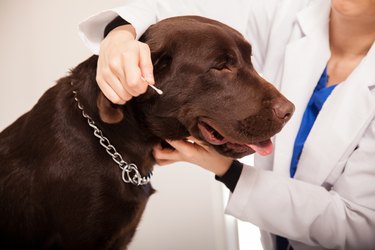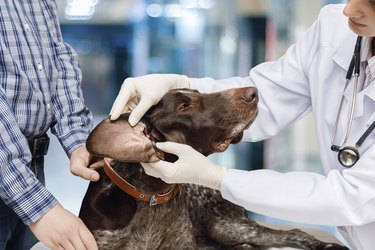Ear infections are fairly common among dogs and are usually caused by yeast or bacteria. Treating the infection depends on properly diagnosing the cause. A vet will typically collect debris from inside the dog's ear to determine precisely what type of infection is at play. Prescription antibiotics or antifungals with or without steroids are often used to treat ear infections in dogs.

Video of the Day
What causes a dog's ear infection
If your dog is shaking his head a lot and scratching his ears, he may be responding to an ear infection. Yeast and bacteria can cause this type of discomfort, as well as redness and discharge leaking from his ears. Generally, a bacterial or yeast infection in a dog's ear is a secondary occurrence, developing in response to inflammation and an unhealthy environment in his ear. A variety of factors can contribute to ear infections, including:
Video of the Day
- Mites
- Allergies
- Foreign material in the ear
- Systemic illness, such as hypothyroidism
- Growths in the ear canal
- Excessive moisture, hair, or wax
Another illness or allergies are usually the primary cause of the problem. Additionally, ear infections that begin in the outer ear can progress into the middle or inner ear, if left unchecked. Successful long-term treatment of an ear infection requires addressing the primary cause of the infection.
Treating ear infections in dogs
In some cases, the vet will clean the dog's ear before administering any medication so the ear doesn't provide an environment that fosters more bacterial or fungal growth. Treatment usually involves a liquid, ointment, or cream antibiotic applied directly into the ear. Occasionally, the vet may administer an injection or prescribe oral antibiotics to provide a faster response to the infection. In the case of a yeast infection, antifungals are necessary and steroids also may be part of the treatment regimen to reduce inflammation and swelling.

Ear infection medicine for dogs
There are a host of antibiotics to choose from when it comes to treating a dog's ear infection. The type of drug chosen depends on what type of infection the dog has. Many medications contain an antibiotic combined with an antifungal and steroid.
- Otomax is a combination ointment, combining the antibiotic gentamicin with the antifungal clotrimazole and the steroid betamethasone.
- Tresaderm is composed of the antifungal thiabendazole combined with neomycin as an antibioticsteroid dexamethasone, administered as drops.
- Panalog is the combination of an antifungal known as nystatin, neomycin, the antibacterial thiostrepton and triamcinolone acetonide, a steroid. It's available as an ointment, cream, or in tablet form.
- Mometamax is an ointment containing gentamicin with clotrimazole and the steroid, mometasone.
Some topical medications are simply antibiotics, such as Baytril otic, a liquid form of the broad-spectrum antibiotic enrofloxacin.
Oral antibiotics for treating ear infections in dogs
Occasionally, a dog requires additional antibiotics, particularly for more persistent, hardy forms of bacteria, such as Pseudomonas aeruginosa. Oral antibiotics in the quinolone class, such as enroflaxin and orbiflaxcin are effective at taking on more resistant bacteria. Cephalexin can be useful for stubborn ear infections. Though not an antibiotic, oral ketoconazole is an antifungal sometimes used to treat yeast infections.

Possible side effects of medications to treat dog ear infections
Depending on the medication, a dog may experience irritation, swelling, or redness in his ear as a side effect. Some dogs develop temporary deafness when taking certain ear ointments or using ear packing material. Your vet should tell you about any possible side effects of a medication before you begin using it.
Your vet should ensure your dog's ear drum is intact before administering any topical ear medication. Administer all medication as directed by your vet, even if the ear looks healed.